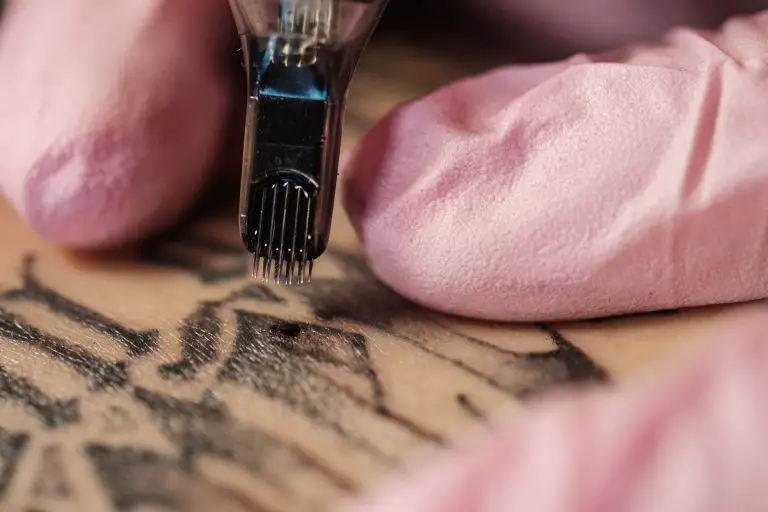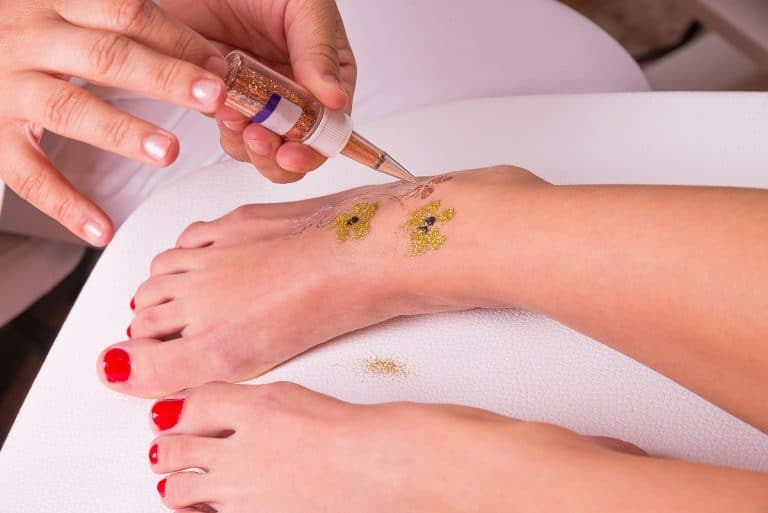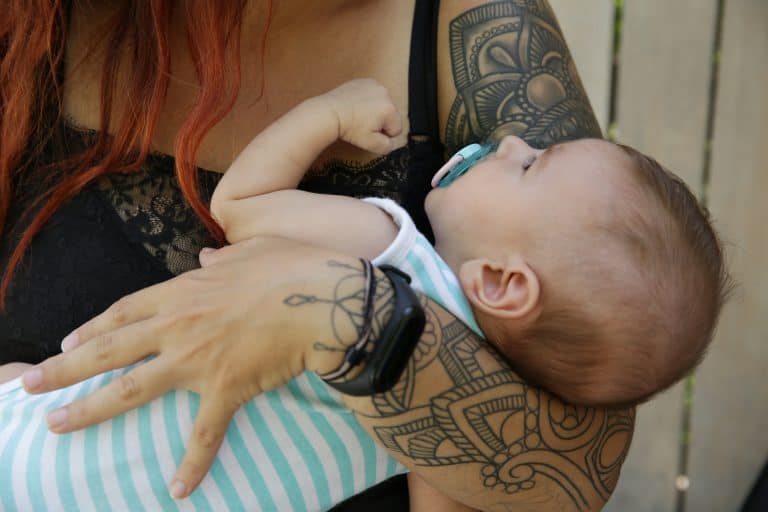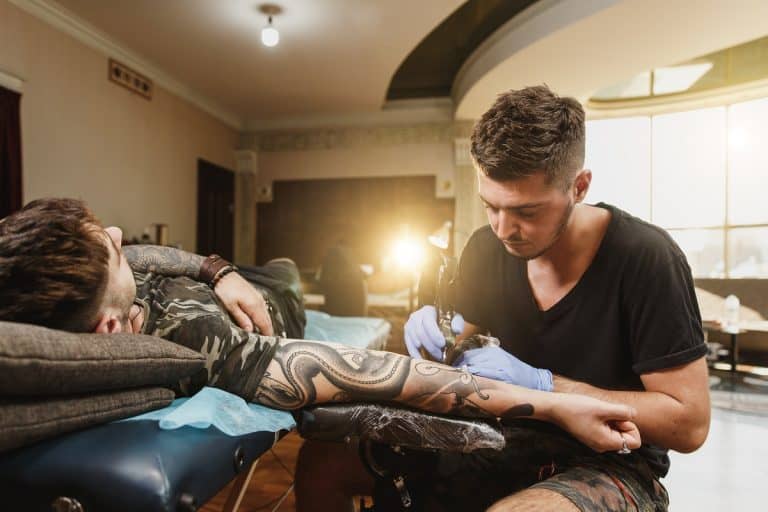How Long Does It Take For A Tattoo To Heal: Step By Step Guide
So, you’re at the tattoo studio and you just got some new, fresh ink. Of course, one cannot help but wonder how long it will take for the tattoo to heal, so you can show it off and wear it with pride.
In the following paragraphs, we’ll take a look at the usual healing process and timeline every tattoo goes through. So, without further ado, let’s see what you can expect from the healing process and how long it might last.
Tattoo Healing Stages: Step By Step Guide
1. Day 1 – Fresh Wound
The moment your tattoo is done and wrapped in saran wrap or bandage, it is considered an open wound. Tattooing is considered a sort of medical procedure, so the tattoo is an open, fresh wound that requires proper aftercare.
During the first day, your tattoo should be wrapped and protected and kept so at least overnight. You should be wearing some loose clothes and avoid touching the tattoo.
Also Read: Wearing Clothes Over a New Tattoo: Can You Do It and How?
2. Days 2 to 3 – Still A Fresh Wound
At this point, you can take the bandage or the saran wrap off. Because the tattooed are is still a fresh wound, you may notice redness, warm or burning sensation, and of course, oozing and swelling. All of this is a completely normal reaction of your body.
However, you may need to wash the tattoo with antibacterial soap, tap to dry, and leave it as it is. There’s no need to re-wrap the tattoo because it needs to breathe and dry naturally.
3. Week 1 – The Healing Signs
If you’re doing the aftercare routine properly, during the first week you may notice some healing signs; itching, flaking, and scabs. This is a completely natural occurrence, however, you must refrain from touching and picking on the tattoo. If you do scratch and peel the tattoo, the healing process will only prolong and you may disrupt the ink completely.
At this point, you don’t need to wash the tattoo as often, but you will need to moisturize it, twice a day max (once in the morning and in the evening).
4. Weeks 2 to 3 – The Healing Progresses
In between the second and third week, you may notice the scabs coming off on their own, and the itching completely reducing. This is a sign that the healing progresses and the new skin is forming over the tattoo.
Make sure to still keep the tattoo moisturized, and do not wash it; however, you can take showers regularly, and tap the tattoo to dry it. Do not dry the tattoo using a towel or an aggravating cloth; tap dry it with a paper towel instead.
Also Read: Showering With a New Tattoo: Can You Do It and How?
5. Week 4 – Half Way To Go
At this point, the surface layer of the skin should be healed completely. However, the deeper layers of the skin are yet to heal. But, if at this stage your skin is still red or reddish, itchy, and hurts to touch, then make sure to talk to a doctor or your tattoo artist since you may experience an infection.
If this isn’t the case, continue the regular aftercare routine (moisturizing and non-frequent washing), and refrain from touching, scratching, picking, or peeling. The tattoo will appear a bit cloudy and dull in appearance, but this is perfectly fine since it will become more vivid as the dry skin starts coming off.
6. Months 3 to 6 – Completely Healed
After several months, your tattoo should be fully healed, including all the affected skin layers. There should be no itching whatsoever, and the tattoo will appear vivid, bright, and vibrant. From this point, you can stop the regular moisturizing, but make sure to wear sunscreen with a protective SPF.
Also, try to lower sun exposure of the tattoo, and continue wearing loose clothing. You can start taking longer baths or swimming since the skin is healed and the water won’t cause any issues.
Tattoo Healing Duration
The tattoo healing stages and duration may differ from one tattoo to the other. The healing duration depends on several factors, like;
- The style of the tattoo
- Whether it is grey or colored
- The size of the tattoo
- The location or body placement
- The execution of the tattoo artist
- The time the tattoo was wrapped and protected
So, taking into consideration the factors, we can determine an estimated healing duration for different tattoos;
- Colored tattoos – the colored tattoos take the longest to heal. The reason for this lies in the very tattooing execution when coloring the tattoo. The needle has to go over every inch of the tattoo to fill it in with color, without any breaks. The increased work irritates the skin more, leading to skin trauma, and later, longer periods of scabbing and overall healing. So, while the healing process is estimated to 2/3 weeks, a colored tattoo may take between 4 and 6 weeks to have at least the surface skin healed.
- Black & grey tattoos – these tattoos heal much faster than the colored ones. The reason for this lies in the less intense approach to the skin. These tattoos often have some blank space or some light shading, which doesn’t irritate or damage the skin as much as the coloring does. Such a tattoo may take up to 3 weeks to have the surface skin healed if taken care of properly.
- Tattoos with sensitive body placement – if a tattoo is placed in an area that has very thin skin and a lot of nerve endings, the damage to the skin might be greater. That is why any type of tattoo done in a sensitive area takes much longer to heal than expected. You may experience longer periods of redness and irritation, and the skin may even be itchier during the healing process. The overall healing duration for a sensitive tattoo may be up to 6 weeks, but there were cases where the healing lasted for several months (just the surface skin layer).
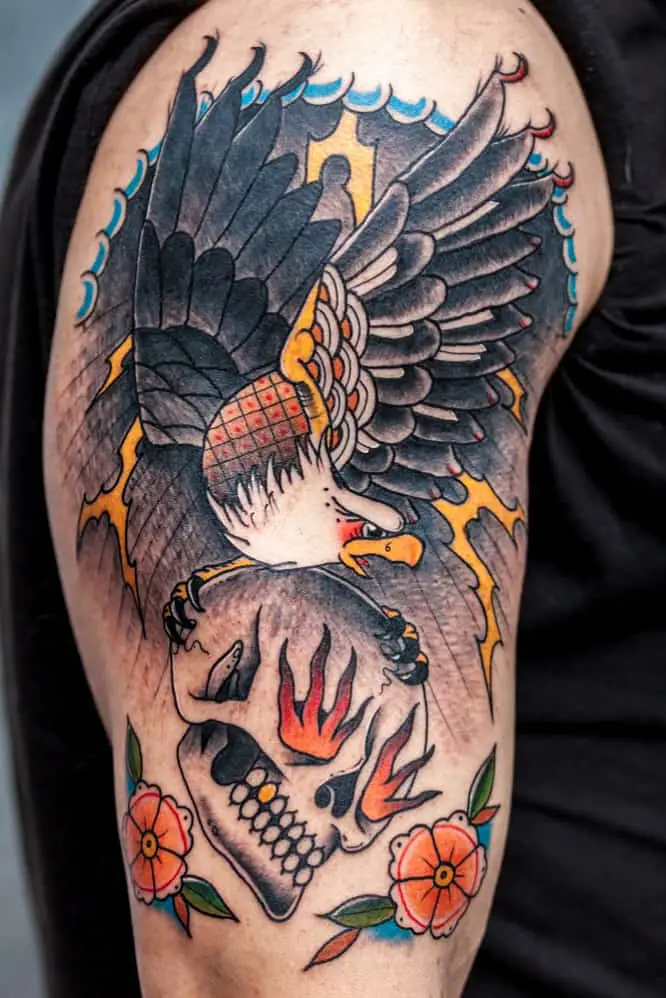
Tattoo Healing: More FAQs
How Can I Promote Faster Healing?
- Make sure to always wash your hands with soap and lukewarm water before touching the tattoo.
- Make sure to clean the tattoo using antibacterial soap and lukewarm water.
- Do not overwash the tattoo, especially while it’s fresh.
- Tap dry the tattoo with a paper towel; other fabrics may aggravate it and prolong the healing process.
- Do NOT moisturize the fresh tattoo; it is still a fresh wound, and applying lotion onto it may cause skin issues and prolong the healing process.
- Avoid putting too much moisturizer, since it can promote scabbing and prevent the skin from breathing.
- Wear loose clothes that cover the tattoo.
- Avoid swimming and taking baths; taking showers is fine.
- Make sure to NOT scratch, peel, pick or touch the tattoo while it heals.
- Keep hydrated and eat well to keep the skin and your metabolism healthy.
- Make sure to boost your immune system, to help the body fight off infections and heal the tattoo faster.
What Are The Signs Of A Tattoo Infection? (And How Can You Prevent It?)
It is normal to have skin redness and tenderness right after you get a tattoo. The skin is irritated and has undergone a lot of damage, so its reaction to such treatment is burning, sensitivity, redness, etc.
However, if such skin changes continue to occurs after a week or two, and the symptoms don’t subside, then we’re talking about an infection. So, the most common signs of a tattoo infection include;
- Redness – prolonged redness, lasting more than a week
- Swelling – swollen and puffy skin days after getting a tattoo, especially the surrounding skin (may indicate an allergic reaction to the ink)
- Burning sensation – the tattooed area feels incredibly warm, almost as if its burning or experiencing a fever
- Tenderness – the tattooed area is tender and painful to touch, even a week after getting a tattoo
- Foul odor – this is a clear indication that the tattoo is infected and you need to seek medical attention
- Pus or oozing – if the tattoo continues to ooze after 2 or 3 days, it is probably infected
- Itching and hives – in some cases itching and hives indicate that you’re allergic to ink, so you might need to talk to your doctor
- Scarring – is scars occur after the tattoo starts scabbing, it is not healing properly due to an allergic reaction or infection
- Fever or chills – in this case, you need to see the doctor right away, since fever and chills indicate the tattoo is infected
If any of these symptoms occur after a week or two, make sure to talk to your tattoo artist, doctor, and dermatologist. They should be able to provide proper information and treatment recommendations.
If you’re wondering how you can prevent a tattoo infection, you should be aware that the prevention starts at the moment you choose a tattoo shop and you sit down to get the tattoo. What we mean to say is that you should be observing your tattoo artist and their hygiene practices. For example, are they using sterilized equipment, gloves, whether they’ve washed their hands, etc.
Don’t be afraid to ask your tattoo artists to sterilize the equipment in front of you and to use a brand new needle. Dirty, old, and unsterilized equipment (especially needles) can spread diseases like tetanus, HIV, or hepatitis.
Also, after the tattoo is done, make sure to not touch it without washing your hands first. If you do so, you can prevent bacteria from transferring from your fingers onto the tattoo, which could otherwise cause infection.
Can You Get A New Tattoo While One Is Healing?
Getting a new tattoo while already having one that’s healing can be a tricky endeavor. We’re not going to talk about issues like the cost, but rather the very issue of having two tattoos healing at a close or the same time.
Now, to have one tattoo healed completely, the body needs to fight a lot to prevent infections and keep everything healthy. But, getting a new tattoo in the middle of the healing process can overwhelm the body and therefore prolong the healing process of both tattoos.
So, instead of waiting a few weeks for a tattoo to heal, you’ll wait for a few months until both tattoos are fully healed. Not to mention the aftercare issues and the overall prepping of your body through hydration, nutrition, and metabolism boost.
So, technically you could get a new tattoo while one is healing, but you need to be aware of the complications this might bring to the overall healing process and its duration.
If you can, try to wait one or two months to get a new tattoo, since by then the other tattoo might be healed, at least at the surface level. This will cut you some slack when it comes to the aftercare routine, and of course, your budget.
More to know: Tattoo Aftercare Instructions: How To Take Care Of A Tattoo?Final Thoughts
Getting a new tattoo is an exciting moment, and naturally, you want to show it off as quickly as you can. But, it is essential to be patient and take care of your tattoo, since it is something that will stay on your body permanently.
Because this is a lifelong commitment, you want to let it heal completely, and not worry about the time it will take to do so. All you can do is follow your aftercare routine, eat healthy food, drink a lot of water, and wait. If you do notice any of the infection symptoms, make sure to seek medical attention or talk to your tattoo artist.
- Safe, non-toxic plant-based temporary tattoos made with 100% high-definition printing for a realistic look without the pain
- Easy to apply and remove - just stick for 20 seconds then take off
- Set includes 5 sheets with 17 fun, delicate designs like hearts, cats, smiles, suns, moons, and more
- Waterproof and long-lasting - stays on up to 2 weeks of wear
- Fashionable for women, men, girls and boys
- Place on arm, wrist, neck, leg, finger, waist, foot and more
- Great for parties, birthdays, and showing your unique style




